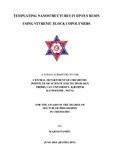Please use this identifier to cite or link to this item:
http://archive.nnl.gov.np:8080/handle/123456789/327| Title: | Templating nanostructures in epoxy resin using styrenic block copolymeers |
| Authors: | Pandit, Rajesh |
| Keywords: | Epoxy resin Block copolymer, nanostructures Nanostructures FTIR spectroscopy Electron microscopy Epoxidation Microhardness Deformation behavior |
| Issue Date: | 24-Dec-2018 |
| Abstract: | Styrenic block copolymers based on polystyrene (PS) and poplybutadiene (PB) having various molecular architectures were subjected to epoxidation reaction to different degrees by various methods using m-chloroperoxy benzoic acid (MCPBA), performic acid (PFA), peracetic acid (PAA), and hexafluoro isopropanol (HFIP). The epoxidized copolymers were blended with diglycidyl ether of bisphenol-A (DGEBA) based epoxy resin, an amorphous material. Further, the nanocomposites with boehmite and layered silicate nanofiller were prepared. The materials were characterized by different techniques such as fourier transform infrared (FTIR) spectroscopy, scanning electron microscopy (SEM) and transmission electron microscopy (TEM), thermogravimetric analysis (TGA), differential scanning calorimetry (DSC), and depth sensing microhardness measurements. The chemical modification of the block copolymers was confirmed by FTIR spectroscopy. All the methods used for the epoxidation of block copolymers were found to be feasible. However, the MCPBA method was found to be practical and most selective one in terms of time, cost and ease of controlling reaction conditions. The FTIR peak intensity at 966 cm-1 corresponding to the cis conformation of C=C double bond decreased with increase of degree of epoxidation implying that the epoxidation reaction favoured at cis - position of the double bonds. Highly cross-linked network was formed between the epoxy rings and amino groups in blend. The macrophase-separated spherical domains of epoxy resin were formed at lower epoxidation degree the block copolymer in epoxy resin blend. Highly ordered nanostructures were induced by the epoxidized block copolymers in the epoxy resin at higher degree of epoxidation. The ordered structures thus formed in epoxy resin blends had periodicity of 50 nm, the dimension well below the wavelength of visible light indicating that the nanostructures were templated by the block copolymer. Hence, the dispersion of nanofiller was homogeneous in composites and most of the composites were transparent to visible light. The addition of epoxidized copolymer offered the possibility to increase, besides imparting an enhanced toughness, the thermostability of the materials but lowering the flame retardancy. In contrast to highly brittle behaviour of the neat epoxy resin, the micro- and nanostructured blends exhibited highly ductile behaviour. The blending of the epoxy resin with 30 wt.-% of epoxidized block copolymer caused a decrease in hardness by more than 50% while the addition of 3 wt.-% of nano-boehmite significantly compensated the loss in the hardness. The epoxy resin blends as well as their nanocomposites revealed intense plastic deformation as demonstrated by fine fibrillar structures leading simultaneously to enhanced toughness and stiffness of the materials. The observed phenomena may open up the opportunity of synthesizing transparent nanostructured epoxy resins with tailored stiffness-toughness ratio over a wide range. |
| Description: | A thesis submitted to the Central Department of Chemistry, Institute of Science and Technology, Tribhuvan University, Nepal, for the award of the Degree of Doctor of Philosophy in Chemistry, 2015. |
| URI: | http://103.69.125.248:8080/xmlui/handle/123456789/327 |
| Appears in Collections: | 500 Natural sciences and mathematics |
Files in This Item:
| File | Description | Size | Format | |
|---|---|---|---|---|
| Rajesh Pandit Ph D Thesis 2015.pdf | 8.04 MB | Adobe PDF |  View/Open |
Items in DSpace are protected by copyright, with all rights reserved, unless otherwise indicated.